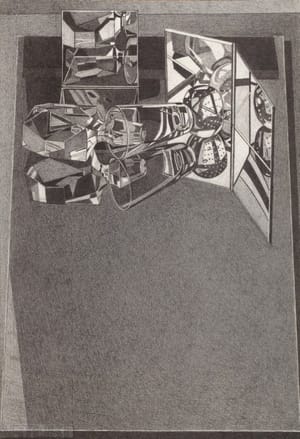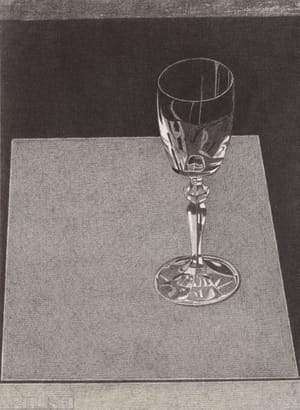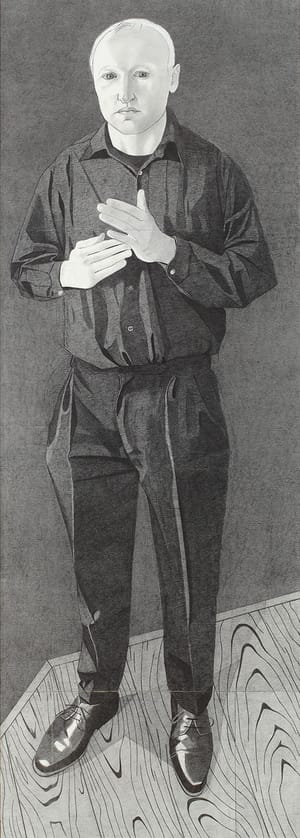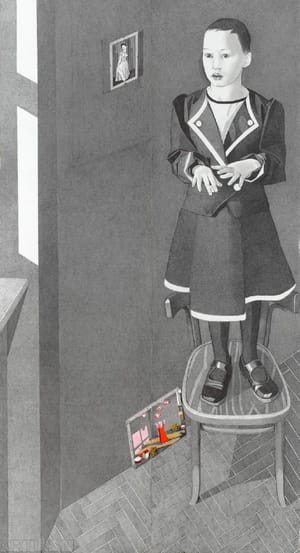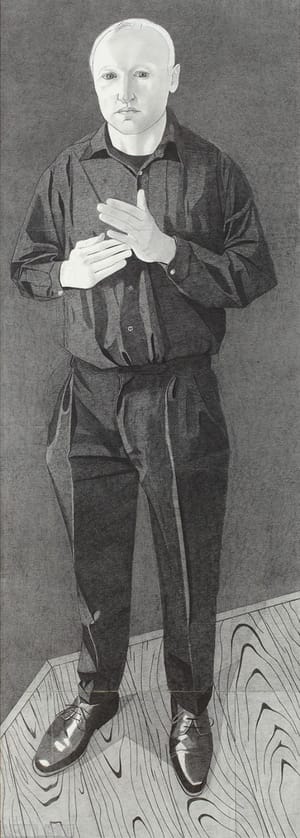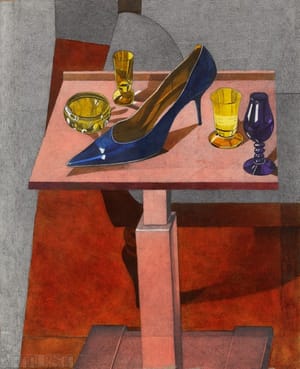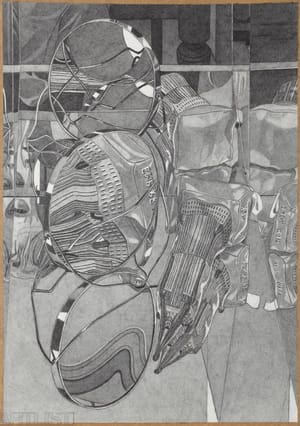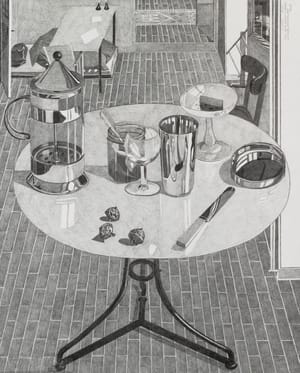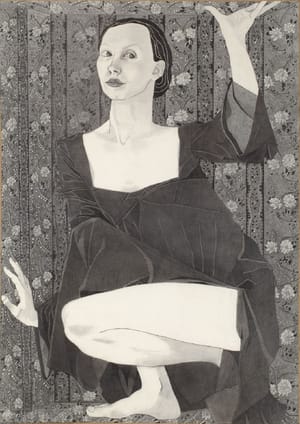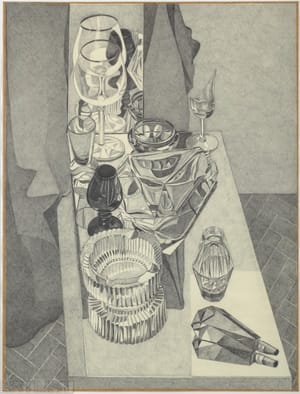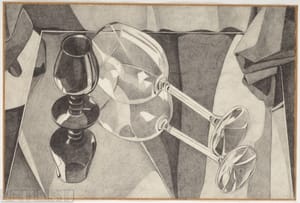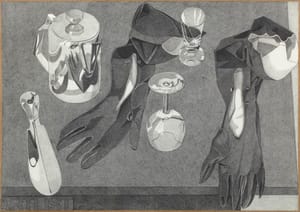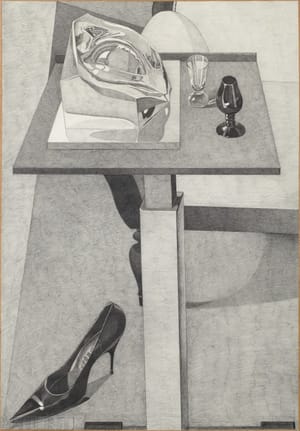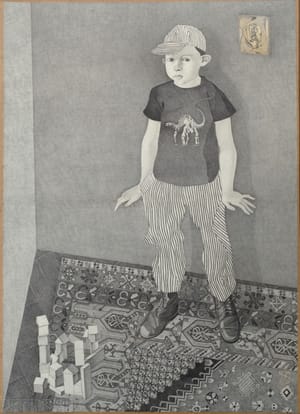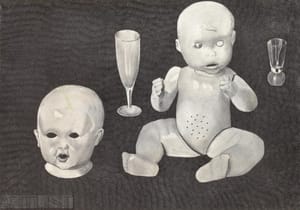- First Name
- Tomáš
- Surname
- Smetana
- Born
- 1960
- Birth place
- Praha
- Place of work
- Novém Městě na Moravě a v Praze
- CSU Library
- ↳ Find in the catalogue
About artist
Tomáš Smetana is a graduate of the Academy of Fine Art in Prague and was known as a painter as far back as the 1990s. Over recent years he has been involved mainly in coloured drawings and specialises in portraiture and still life. He is fascinated by the refraction of light in various materials and the reflections of mirrors. His drawings are almost an optical labyrinth, which is constructed by the artist in advance in reality. As well as the optical game in which we encounter Smetana as a brilliant draughtsman, his still lifes contain a metaphor of artistic endeavour as a reflection of reality.
From the catalogue:
Tomáš Smetana is exhibiting a selection of his remarkable work in the gallery Sokolská 26 in Ostrava. With a thoroughness bordering on obsession he has now for the second decade been drawing exclusively through the medium of an HB 0.3 mm micro-pencil. His still lifes and portraits are the result of a long, laborious process of drawing objects and person in bizarre circumstances. However, he is not simply concerned with attaining aesthetic pleasure, i.e. beauty, but moving to the core of being and to a reality that is magical and difficult to grasp.
He focuses on investigating the boundaries of reality and fiction. At first sight it appears that Smetana’s pencil drawings are scientific in nature. However, what marks his drawings out from this discipline and raises them above it is the admixture of magic. He is aided in this by the monochrome of grey in many different nuances, which in his latest works is sometimes heightened and highlighted by the colour contrast of pastel, the blossom of anthurium or lily.
The artist’s meditative work invites us to contemplate, reflect and experience, to see and experience something that we would otherwise probably never see. If the terms magic and fantastic realism had not already been often appropriated in the history of art, for instance by the Viennese school of fantastic realists, I would not hesitate to call Tomáš Smetana a fantastic realist.
Milan Weber
-----------------
TOMÁŠ SMETANA DRAWINGS
Create your own tradition
Acceptance and project
“The fact that the tradition I have decided to accept exists for me is caused by me alone,” writes Merleau-Ponty in the introduction to his magnum opus The Phenomenology of Perception.
According to the French philosopher tradition is not a given. On the contrary, we create it ourselves when we decided to accept and collect from our past something we wish to take with us into the future. Because “that which is have adopted is only genuinely adopted if we transfer it into a new movement”. We decide to take part of our own history further. Merleau-Ponty says that “the living present is torn between the past that it adopts and the future that it plans”. Tradition therefore exists where a certain plan or project (Fr. projet) arises from acceptance (Fr. reprise) of the past and where acceptance enters into the future project.
The most important function of tradition is not to be recollection but to provide me with the basis for a new project, or, in the words of Merleau-Ponty, a plan of the future. Only when I accept tradition, when I take it upon myself, give an undertaking that it will genuinely exist for me, that it will become me. And perhaps it is the case that I must appropriate my tradition in order to perceive myself clearly in my own context.
Customs, forgetting and new life
Merleau-Ponty explains tradition by quoting Edmund Husserl. It is “the ability to forget sources and ensure for the past not survival, which is the cowardly form of forgetting, but a new life, which is a heightened form of memory”. Customs play a crucial role in our lives. They are characterised by the fact that they have forgotten their sources, they are the past that operates in the present without our being aware of this. A custom becomes a custom only when it finds its place. As sediments customs represent the necessary basis of our existence and perhaps above all our corporeal existence. However, Merleau-Ponty asks: “If custom is not knowledge nor is it automatic, then what is it?” And he replies: “It is knowledge that sits in the hand. It is activated during physical effort and cannot be translated into objective concepts.” The custom Merleau-Ponty is speaking of is a “pure form of memory”, it is the motor ability seated in the body, a type of intimacy acquired through practice. It is not for nothing that we say that practice makes the master. This is not only true of tradespeople and musicians. It is a generally valid law for everyone who has a body of some kind. The aim of repetitive practice is to shift ability from knowledge to fingers, to liberate it from conscious control and at the same time not to reduce it to the purely automatic.
Tradition is both forgetting and remembering. It takes us forward along with what we, the bearers of tradition, bring to it. It is a process of coming into existence: plan, practice, settlement, forgetting, acceptance, adoption, a new plan. Coming into existence is an existential condition that, according to the phenomenologists, stands behind the two great constructions of western philosophy: pure knowledge and inanimate matter. However, this is not only about existence in the philosophical sense of the word. It is a concrete, everyday praxis in which the body, not as pure knowledge nor as inanimate matter, operates.
Certain forms of artistic practice clarify tradition as a constant process of coming into existence, which it genuinely is.
Tomáš Smetana
One could say that when drawing Tomáš Smetana creates tradition. The result is an ongoing adoption of a story that lives. The fact that someone feels a stronger need than others to perceive themselves in relations, continuity and tradition is no doubt for personal reasons. This personal tradition provides the artist with continuity thanks to which his work is unique and at the same time recognisable. However, in this case tradition assumes a technical skill based on many years of practice and established customs, i.e. from motor functions that allow the artist to create thanks to that special blend of concentration and absence of spirit that characterise customs. “The work flows from itself. I don’t need to concentrate, I can leave myself and move in space. It is important to remain a while, to give yourself time. A drawing can’t be finished in a single day. I don’t draw in order to create a picture. I draw in order to feel how time is passing. The main thing is to fill the day with an activity and not to bother my family.”
Duration for Smetana is important when selecting technique and motif:
Technique
The method by which Smetana draws is very slow. “It is a certain kind of very slow method of reconciling myself to my own thoughts. It is not about drawing, but contemplation, a way of being present. It is about the experience of spending hour after hour in the same place. This is reflected in the drawing. The slowness, the process of maturation and the process of thinking is important.” Smetana emphasises that his work is manual. “It is nothing other than manual graphic work. Manual work that I taught myself thanks to the hundreds of drawings I have crosshatched.”
In all truth we can say that drawing for Smetana is now a custom, that he has it in his fingers. He has been “crosshatching”, as he puts it, since the start of the 1990s. He no longer needs to be fully consciously present in order for his hand to work and find the solutions he needs. Even the largest format he crosshatches patiently using minute lines. Although his crosshatching tends to be sparse or more dense, recently he has been thickening many surfaces so long that they acquire a dark, almost silken depth using the micro-pencil and the thinnest pencils he can find. He is convinced that the energy he invests in the work process accumulates in the energy of the picture. “I deliberately restrict myself to pencil and fill the entire surface. I thicken the drawing with energy.” But he also does this in order that these small, rhythmical movements of his hand that crosshatching the paper require and that represent part of his motor function acquire time and can transform him into a state of meditation in which the hand works while the spirit travels. At such moments he feels most creative.
Shortly after 2000 he began to use coloured pencils, though these have a different function. “When I draw using coloured pencil, I draw harshly, I unwind.” The paper then almost glows and is intensively satiated. Other times he colours part of a pencil-drawing in Indian ink: “This is about emphasis. Indian ink is transparent and the content continues to be visible, as in old photos.” While impermeable surfaces result from coloured pencil, Indian ink creates a transparent space.
Architectural sections are characterised by lines. However, he creates his drawings using these lines, one alongside another, tens of thousands of them. Smetana’s drawings are sometimes unbelievably detailed, but never exaggeratedly punctilious, perhaps because his spirit transports his hand. Hand and spirit hold each other in check. He monitors his work with that distracted attention described by Merleau-Ponty. He does not own the image in advance but has only an unclear idea that his hand gradually clarifies. “I don’t decide about the future. I proceed in such a way that I reach decisions one after another.” “Sometimes you feel that a drawing will be interesting.” “I never make any rash step. I draw something and then it occurs to me that I have to draw something else, and this continues until I have the whole drawing.” Of course Smetana draws his drawings. But he experiences the process in such a way that the drawing reveals itself. Thanks to these pencil lines that cover the paper the drawing appears.
Motifs
The drawings are clearly figurative, even though not directly naturalistic. They represent people or objects or both together. “To begin with my work was stylised. Now it is closer to realism.” Perhaps it is a kind of “fantastic or magical realism”. The people he draws are friends and acquaintances or members of his family. The items in his drawings are usually commonplace: furniture, games, shoes, wallpaper, carpet ... a special place is occupied by the smooth, often translucent surface of glass, plastic film, mirrors, pots and pans. “Still life represents a reflection of the past.” Reflections are not simply a repetition of what is mirrored. Smetana collects them and clarifies the life we lead and which we can decide to ignore or adopt. His work is a constant process of collection in which he takes everyday items, investigates them, and accepts them into or rejects them from the personal tradition that he is creating through art.
“I take a suitcase and put things inside it in a completely random way. For instance, my father’s ashtray or my mother’s shoes. But I don’t take it completely seriously. Maybe they aren’t my mum’s shoes. A kind of legend appears, I create my own personal mythology.” The high heeled shoes that perhaps belonged to his mother and perhaps not and in which she danced, according to Smetana, already feature in his early drawings. He took them over and incorporated them into his “personal mythology”. Even if they were fictive, they are nevertheless real, because they have the ability to make the dead present in Smetana’s tradition.
This relates not only to his mother but to the entire world of the past. “Certain items reappear again and again in my drawings: a First Republic rug, a cubist writing table belonging to Aunt Vlasta, a nest of coffee tables, a chair, a chest of drawers – things I have a certain relationship with. I remember a time when there existed hallways, salons and bedrooms, a period with certain aesthetic and human values that had their elegance. Manual work was also accorded value at that time.” Items from the past played a different role under communism than they do these days. Smetana believes they have lost their function. We find them in coffee bars and restaurants as decorations that mean nothing. But back then they were rare and full of significance. The few items remaining to grandma were not fragments of a reflective world that the communists destroyed, they were not items from a world that Smetana never knew, but represented possibilities in his own life. When he visited his grandma as a boy, she would tell him stories about his father who had been a GP to a Bulgarian Tsar, and about her own husband, Smetana’s grandfather, who had been an evangelical bishop in Czechoslovakia. These sounds and colours were different to those Smetana saw around him in the housing estate where he grew up. They were colours and sounds he could either incorporate into his personal tradition or exclude.
Smetana does not draw his aunt’s writing table out of nostalgia. He does not need the property that the communists confiscated. All he needs is a single shoe, which in reality does not even have to have belonged to his mother. Nevertheless, it brings her close to him. Tradition is not a museum. Just as Merleau-Ponty says that tradition is not about ensuring the past survives but giving it new life, so the tradition that Smetana has decided to accept is not the past but an expansion of the presence and an opening on the future. “Sometimes an object has a certain past and can tell a story. I collect the stories that cling to my drawings.” The insignificant acquires new significance when Smetana includes it in his drawings, especially when he uses it again and again and insists that these objects represent links within the framework of his personal tradition.
It would not be correct to say that Smetana is in thrall to the circumstances in which he creates or the people he misses. At the moment he includes them in his work he himself readopts them and gives them new life by taking them into his own life.
In his description of the creation of an artwork Merleau-Ponty criticises the approaches taken by art history, i.e. both the biographical method, which perceives the artwork as a reflection of the external life of the artist, and the psychoanalytical method, which imagines the work to be a reflection of the artist’s interior world. Both perspectives are reductionist to the extent that their deterministic explanations overlook the creative recreation of the circumstances of an artist’s life, which is what characterises the artist as artist. “If we assume a position inside the painter in order to participate in that decisive moment at which a ‘motif’ crystallises as his physical fate, personal adventure and historical circumstance, then we ignore the fact that his work is never the consequence of his answering these given circumstances and that the body, life, landscape, schools, lovers, sponsors, police, revaluations that could destroy the painting are also the bread from which the painting lives. Living in a painting means breathing this world, above all for the person who sees in the world something that can be painted, which is to a certain extent everyone.”
Smetana speaks of a “mental process consisting of the fact that we learn to see significance and aesthetic value in every individual objects.” When he incorporates objects and people in his drawings, this is more than simply repeating and discovering people and objects in his surroundings. It is a special form of re-cognition. “The pleasure from re-cognition arises from the fact that we recognise more than simply something we know. That which we know appears during re-cognition as a kind of enlightenment from all randomness and variability of the circumstances upon which it is conditional, and is understood in its being. It is re-cognised as something. (…) The ‘known’ comes into its own being and is shown to be something that is only by virtue of its re-cognition.”
The term re-cognition as used by the hermeneutist Hans-Georg Gadamer is related to what Merleau-Ponty means by the term acceptance.
Composition
In re-cognition and acceptance that which first arrives as chaos is then organised in a certain way. Organisation is skill, and during acceptance lived experience acquires a form and is incorporated into a certain composition. “I rearrange things until I find the ideal composition. Aesthetic calm is important, I have to like it. I try to create order in the composition and in the distribution of individual planes. I work from the whole to details, from the general to the particular, and then back again to the whole. I create unbelievable spaces, abstract compositions. I try out various formats. But I’m still only at the start. I concentrate on making the surface clean, as clean as silk. Certain moments are complicated, certain surfaces boring. Boredom has to be alternated with concentration. The entire body is involved, the tension grows until the decisive moment.”
The body and our view of the world
We all have a body and it is our body that designates the angle from which we view the world. Without the body and this angle of view we would not see anything of the world. On the other hand, the world that we see is always deformed by our angle of view. Nobody can see an “objective” world. This deformation creates our world out of the world and allows us to perceive it as meaningful, as a living world. However, our experience of this meaning depends on an important assumption. “Meaning arises when we subject the givenness of the world to ‘coherent deformation’.” Deformation is a necessary consequence of embodiment, though its coherence depends on our creative abilities and will. To see meaning means above all the meaning of creating.
The body influences not only our view of things but also our creative abilities. “Our handwriting can be recognised independently of whether we write letters using three fingers on a piece of paper or using chalk on a blackboard with our entire hand.” However, Merleau-Ponty adds an important corollary: “Our form of handwriting is not bound automatically to certain muscles in our body that had the task of performing given, materially determined movements, but is a general motor ability to formulate and carry out transpositions that create an integrated style.”
Style
We all have a body, but if our eyes and hands deform our perceptions, they can also form our conduct in a coherent way or certain style. This is the special task of the artist and his style is nothing more than coherent deformation that is underlaid by the world that he paints. “In the case of each painter style is a system of equivalences that he makes for himself which manifests the world he sees; it is a universal sign of “coherent deformation” that takes place when the artist concentrates the meaning that was present in his perception only vaguely and gives it an explicit form.” Coherence means connection, and we understand that it is decisive not only for the painter’s style but for the painter to find meaning in that which he sees around him and to manage to express this meaning meaningfully in that which he paints. Basically, coherence is simply another world for tradition that the artist permits to exist for himself and for others when he decides to accept it.
Smetana is a master of drawing objects, which he selects as his motif. He depicts them clearly and distinctly, even though they are complicated and include many details, such as wallpaper with Japanese ornamentation. He is proud of what is called the academicism of his work, i.e. a scholastically precise presentation of a well organised composition or life model. Here too we find something special in his drawings that does not belong to academicism and which he is even more proud of. It is not only a kind of awkwardness to the method of drawing, a certain ubiquitous stylisation. It is also his perspective. As in the case of Cézanne, and especially M. C. Escher, certain objects are seen from one point, while others from a different point. Often this point is so high that the vanishing point lies beyond the surface of the picture.
Classical central perspective is based on geometrical laws. Up till now central perspective has been an attempt to reconcile the subjective gaze with the objective presentation of reality. But Smetana is obviously not interested in the objective presentation of reality. In order to be objective he would have to exclude artistic freedom, and as soon as the artist imprints his style, he ceases to be objective but becomes artistic. However, Smetana is not interested in objective reality even in itself, since such reality has no meaning. Perhaps it has certain properties, but one can only speak of meaning within a concrete situation. Smetana creates a certain kind of unreality and his particular perspectives make it clear that he is not attempting to achieve objective validity, but to find an artificial space, i.e. the space of art. That space finds itself and we find art in it. The objects that Smetana uses to fill up the space are not interesting by virtue of their objective properties. They only become interesting in that light, that perspective, in which he decides to see them by subjecting them to the coherent deformation that creates his style. This is what takes place when he rescues objects and people from the past and allows them to exist in the present, when he loads them with meaning and makes them part of the tradition he creates.
Tradition begins with our angle of view. “It is this that I have in mind when I say that I perceive my body or my senses, my body and my senses being precisely this habitual knowledge of the world, this implicit or sedimented science,” writes Merleau-Ponty. This is not simply about our sensory perceptions and motor skills that we appropriate through practices and settle in the body. It is also about intimacy with the world, which we appropriate by virtue that we manipulate it. But tradition also presupposes a choice. Merleau-Ponty says that we have to decide to accept this settled knowledge in order that tradition exists for us. Tradition is not fate, it is a choice, and a choice we must confirm again and again. And each time we choose ourselves.
In other words tradition brings with it certain rules of the game that we have to respect if we want to carry tradition. Without rules there is no coherence. Without coherent deformation there is no style. Smetana sometimes creates large drawings, sometimes small. Some are coloured, many are black-and-white, some are both coloured and black-and-white. Some are still lifes, others portraits. Even so, his style is unmistakable and abides by strict rules. This relates to the technique that he learned, developed and adopted. It guides his hand while his spirit roams free. The spirit can be absent only because he has the rules of the game in his body: a clearly expressed volume, a completely flat surface, no shadows or only hinted at, and a depth that is almost always bounded by some shadow in the background. Items without organic relations but often with surfaces that reflect each other in complex harmony. Static arrangements that are in balance, completely motionless, without a hint of movement even where they continue beyond the boundaries of the drawing. An even crosshatching, freer or denser or completely compact, often such that ornament or contour appears as a white field that was missed and is surrounded by darker surfaces.
The rules of the game operate as a kind of frame around the drawing and at the same time open up a space for the game, a space that Smetana masterfully uses when drawing. Each new sheet represents a square on a chess board, on which he moves objects belonging to his tradition as a player moves the pieces. The game has a repetitive character and yet is always new: acceptance and project as in the case of every tradition. For this reason Smetana’s drawing is also based on the pleasure of the game, while the rules of the game are an ongoing challenge to his inventiveness. Sometimes he wins, other times he loses. But with every new drawing it is more and more clear. Tradition is important if a person wants to be clear to themselves, and Smetana is clear for others too.
Mikkel B. Tin
Translated from Norwegian by Marie Novotná
CV
Studies:
1980-1985 Academy of Fine Arts in Prague
Scholarships:
1990 La Foundation pour une Entrainde Intellectuelle Evropéenne
Exhibitions
- Solo exhibitions
-
2010
Výstavní síň Sokolská, Ostrava
2009
Jako žlutá lilie, Galerie České pojišťovny, Praha
2008
Bota po mamince, svatební skleničky, popelníček tatínka z doby, kdy kouři, Galerie města Blansko
2007
13 zátiší, Minigalerie U Zlaté štiky, Kolín
HVB Praha
2006
Kdo jsme, Klub Středozem, Nové Město na Moravě
2003
Kreslené obrazy, Behémót, Praha
2002
Akropolis, Praha
2001
Banka Austria Creditaanstalt - Valdek Praha, s Janem Mertou
2000
Stále znovu, U černého pavouka, Ostrava
1997
Galerie Behémót, Praha
Galerie Ambrosiana, Brno
1994
Panenky, Galerie Pecka, Praha
1993
Nic nevím, JNJ galerie, Malá Strana v Praze
1989
OKO Gallery, Amsterdam
IBC Alan Nicholson Gallery, Paris
- Group exhibitions not included in ARTLIST.
-
2007
Městské muzeum Bystřice pod Pernštejnem
2005
Městské muzeum a galerie, Svitavy
2001
Kantoři / Schoolmasters, Atrium, Praha
1999
Zlínský salon, Zlín
1993
Horácká galerie v Novém Městě na Moravě
1989
Mladí Bauchovi / Youth to painter Jan Bauch, galerie Václava Špály, Praha
Konfrontace, Svárov
Monography
- Personal texts not included in database
Tomáš Smetana, EGOISTICKE PROSTORY 1 Dvě autorské poznámky k výstavě v Horáckém muzeu v Novém Městě na Moravě (11. 4. 2011) Takovým typickým egoistickým prostorem je náš pokoj, byt, případně atelier. Jsem bytový umělec a nerozlišuji příliš prostor atelieru a prostor bytu. Je zabydlen, jsou v něm věci mi blízké, zděděné po rodičích či prarodičích, knihovna postel, stůl z raného období obrazy mého strýce ústeckého malíře. Vše co mám rád, k čemu mám vztah. Ty předměty mne provázejí mým dosavadním životem a jsou stále stejné, jenom jich ubývá. V roce 1997 mě majitel domu, kde jsem bydlel, nuceně přestěhoval. Přestal jsem mít své milie i atelier. Byt jsem sdílel se svojí ženou Klárou. Od té doby jsem vystřídal řadu míst, kde kreslím: chodba v paneláku, kabinet učebny školy, byty svých přátel, které využívám jen po dobu jejich nepřítomnosti atd. Vytvořil jsem si cestovní egoistický prostor, jakousi alchymisticko-psychiatrickou bedýnku, krychli o rozměrech 40x60cm, dvě strany byly odkryty, horní a jedna boční. Uvnitř byla zrcadla. Předmět, který se sám o sobě egoisticky chovat nemůže, to je vlastnost nás lidí, jsem vložil do prostoru, kde se ve 4 zrcadlových stěnách odrážel. Díval se na sebe asi tak jako Narcis do studně na svůj odraz ve vodní hladině. Vkládám do tohoto prostoru předměty jako osobní traumata odlitá do leštěného bronzu (zlatá Jitka - hlavička panenky a zlaté prasátko kasička), nebo skleničky, květiny, hračky a nechám na ně bednu působit. Mám egoistický prostor černý (stěny bedny jsou z černého zrcadla Perla) a egoistický prostor bílý (stěny z obyčejného zrcadla). Egoistický prostor nese pečeť našeho vkusu či nevkusu, našeho vzdělání, povahy, zálib a podobně. Takovým extrémně egoistickým prostorem bude naše rakev, urna, hrob. (16. 2. 2012) Koncem června mi přivezli kresby vystavené v Oslo v překližkové bedně na kolečkách 2m dlouhé, 1.5m vysoké a 20 cm široké. Bednu vyráběl můj kamarád filosof Mikkel se svým bratrem. Umístil jsem ji do svého pokoje atelieru v bytě Makovského 440. Bednu jsem vyprázdnil. Má dcera Antonie jí při náhodné návštěvě objevila a byla jí velmi zaujatá. Vlezla si do ní, přinesla si i polštářek, nějaké plyšové hračky a začala v bedně vegetovat. Do bedny se pořádně nevešla, ramena musela schoulit k sobě. V bedně nakonec usnula, a poněvadž jsem si nevěděl rady jak jí vyndat, přespala v ní celou noc. Následující 3 dny pak v bedně bydlela. Byl to její malý egoistický prostor uprostřed mého velmi egoistického prostoru atelieru. Asi chtěla být se mnou, ale zároveň sama u sebe.
